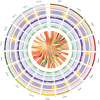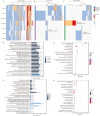The chromosome-level genome of the submerged plant Cryptocoryne crispatula provides insights into the terrestrial-freshwater transition in Araceae
- PMID: 38245835
- PMCID: PMC10873505
- DOI: 10.1093/dnares/dsae003
The chromosome-level genome of the submerged plant Cryptocoryne crispatula provides insights into the terrestrial-freshwater transition in Araceae
Abstract
Plant terrestrialization (i.e. the transition to a terrestrial environment) is a significant evolutionary event that has been intensively studied. While certain plant lineages, particularly in angiosperms, have re-adapted to freshwater habitats after colonizing terrene, however, the molecular mechanism of the terrestrial-freshwater (T-F) transition remains limited. Here, the basal monocot Araceae was selected as the study object to explore the T-F transition adaptation mechanism by comparative genomic analysis. Our findings revealed that the substitution rates significantly increased in the lineage of freshwater Araceae, which may promote their adaptation to the freshwater habitat. Additionally, 20 gene sets across all four freshwater species displayed signs of positive selection contributing to tissue development and defense responses in freshwater plants. Comparative synteny analysis showed that genes specific to submerged plants were enriched in cellular respiration and photosynthesis. In contrast, floating plants were involved in regulating gene expression, suggesting that gene and genome duplications may provide the original material for plants to adapt to the freshwater environment. Our study provides valuable insights into the genomic aspects of the transition from terrestrial to aquatic environments in Araceae, laying the groundwork for future research in the angiosperm.
Keywords: Cryptocoryne crispatula; adaptation; genomic synteny; mutation rates; terrestrial–freshwater transition.
© The Author(s) 2024. Published by Oxford University Press on behalf of Kazusa DNA Research Institute.
Conflict of interest statement
The authors declare that they have no conflict of interest.
Figures




Similar articles
-
Structural characterization and phylogenetic analysis of the chloroplast genome of Cryptocoryne crispatula var. balansae (gagnep.) N. Jacobsen 1991.Mitochondrial DNA B Resour. 2025 Jan 22;10(2):134-138. doi: 10.1080/23802359.2025.2449825. eCollection 2025. Mitochondrial DNA B Resour. 2025. PMID: 39867297 Free PMC article.
-
Phylogenomic Analyses of Alismatales Shed Light into Adaptations to Aquatic Environments.Mol Biol Evol. 2022 May 3;39(5):msac079. doi: 10.1093/molbev/msac079. Mol Biol Evol. 2022. PMID: 35438770 Free PMC article.
-
Phylotranscriptomic analyses reveal multiple whole-genome duplication events, the history of diversification and adaptations in the Araceae.Ann Bot. 2023 Feb 7;131(1):199-214. doi: 10.1093/aob/mcac062. Ann Bot. 2023. PMID: 35671385 Free PMC article.
-
Transitions between marine and freshwater environments provide new clues about the origins of multicellular plants and algae.J Phycol. 2017 Aug;53(4):731-745. doi: 10.1111/jpy.12547. Epub 2017 Jun 13. J Phycol. 2017. PMID: 28509401 Review.
-
Abbreviation of larval development and extension of brood care as key features of the evolution of freshwater Decapoda.Biol Rev Camb Philos Soc. 2013 Feb;88(1):81-116. doi: 10.1111/j.1469-185X.2012.00241.x. Epub 2012 Aug 14. Biol Rev Camb Philos Soc. 2013. PMID: 22891642 Review.
References
-
- Cook, C.D.K. 1990, Aquatic Plant Book. Hague: SPB Academic Publishing.
-
- Cook, C.D.K. 1999, The number and kinds of embryo-bearing plants which have become aquatic: a survey. Perspect, Plant Ecol., 2, 79–102, doi:10.1078/1433-8319-00066 - DOI
MeSH terms
LinkOut - more resources
Full Text Sources
Miscellaneous

